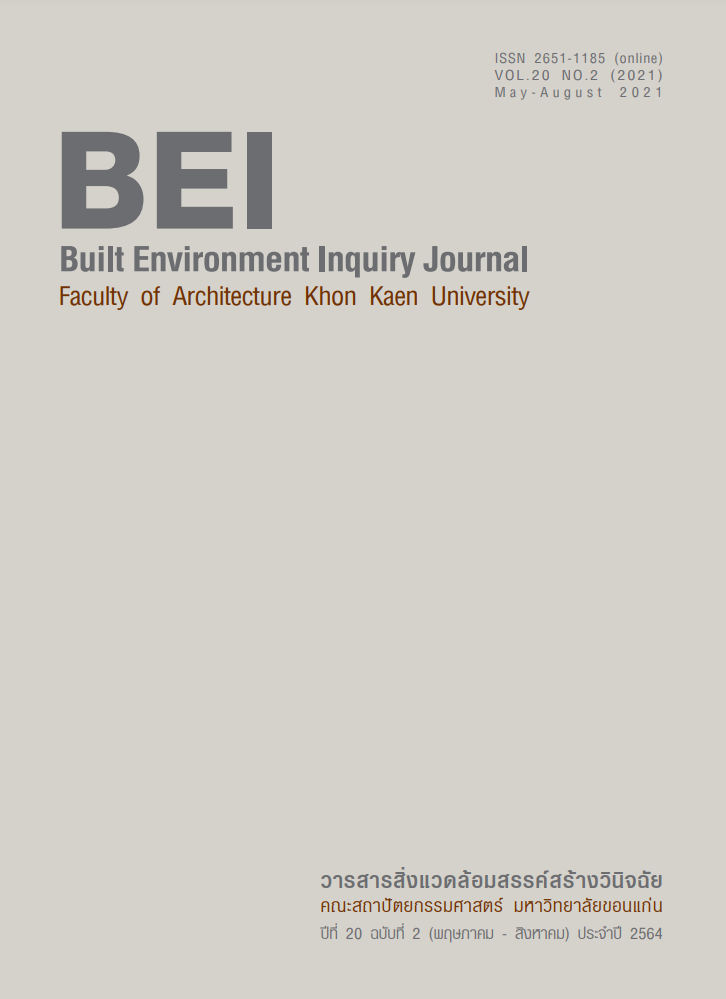The Study of Cooling Load Calculation Error by CLTD/CLF Method Compared to Simulation with DOE2.1E
DOI:
https://doi.org/10.14456/bei.2021.13Keywords:
CLTD/CLF, Cooling Load, DOE2.1E, Percentage ErrorAbstract
Air conditioning system consumes 40-60 percent of the total consumption of residential buildings in Thailand. Therefore, the accurate cooling load calculation can result in efficient energy conservation and the selection of a suitable air conditioning system for the cooling load which can reduce the cost in the part of the air conditioning system as well. In Thailand, CLTD/CLF method is popular because it can be easy to understand in addition fast to calculate the cooling load without having to use a complex computer program, however the results will be less accurate. The purpose of this article is to study of cooling load calculation error by CLTD/CLF method compared to simulation with DOE2.1E
The results of the study of the cooling load calculation error from the wall group selection by CLTD/CLF method comparing between the selecting wall group (Group F) and the neighboring wall group (Group E and Group G), it was found that there is 4.31% error between Group E and Group F, 6.77% error between Group G and Group F and both neighboring wall groups’ average is 5.54%error from the selecting wall group. And the results of the study of cooling load calculation error by CLTD/CLF method compared to simulation with DOE2.1E ver.121 found that the calculation of the CLTD/CLF method with the CLTD values from the selecting wall (Group F) were compared to simulation with DOE2.1E ver.121 has 0.72% error and the calculation of the CLTD/CLF method with the CLTD values from the neighboring wall (Group E and Group G) compared to simulation with DOE2.1E ver.121 has 3.55% error and 7.44% error respectively
References
American Society of Heating. (1989). ASHRAE Handbook of Fundamentals. Atlanta: Refrigerating and Air Condition Engineers.
Pita, Edward G. (2002). Air-Conditioning Principles and Systems. 4th. New Jersey: Prentice-Hall.
The U.S. Department of Energy. DOE-2 Reference Manual Part1 Version2.1. Retrieved January,2021 from: https://doe2.com/Download/DOE-21E/DOE-2ReferenceManualVersion2.1A.pdf
เอกสารอ้างอิงภาษาไทย
Department of Alternative Energy Development and Efficiency. (2016). Studying Energy Consumption Criteria in Resident Building and Creating the Energy-Saving House model Project. Bangkok: King Mongkut’s Institute of Technology Ladkrabang.
กรมพัฒนาพลังงานทดแทนและอนุรักษ์พลังงาน. (2559). โครงการศึกษาเกณฑ์การใช้พลังงานในบ้านพักอาศัยและสร้างต้นแบบบ้านประหยัดพลังงาน. กรุงเทพฯ: สถาบันเทคโนโลยีพระจอมเกล้าเจ้าคุณทหารลาดกระบัง.
Department of Alternative Energy Development and Efficiency. (2018). Studying to Formulate Resident Building Energy Efficiency Standards Project. Bangkok: King Mongkut’s Institute of Technology Ladkrabang.
กรมพัฒนาพลังงานทดแทนและอนุรักษ์พลังงาน. (2561). โครงการศึกษาเพื่อจัดทำเกณฑ์มาตรฐานประสิทธิภาพพลังงานบ้านที่อยู่อาศัย. กรุงเทพฯ: สถาบันเทคโนโลยีพระจอมเกล้าเจ้าคุณทหารลาดกระบัง.
Ministry of Energy. (2558). Energy Efficiency Plan; EEP 2015. Retrieved January,2021 from: http://www.eppo.go.th/images/POLICY/PDF/EEP2015.pdf.
กระทรวงพลังงาน. (2015). แผนอนุรักษ์พลังงาน พ.ศ.2558-2579 (Energy Efficiency Plan; EEP 2015). สืบค้นเมื่อ 10 มกราคม 2564, จาก http://www.eppo.go.th/images/POLICY/PDF/EEP2015.pdf.
Downloads
Published
How to Cite
Issue
Section
License
Views and opinions expressed in the journal do not necessarily reflect those of the editors.



